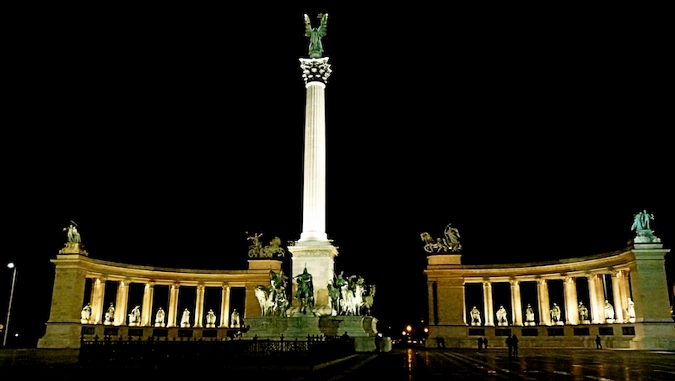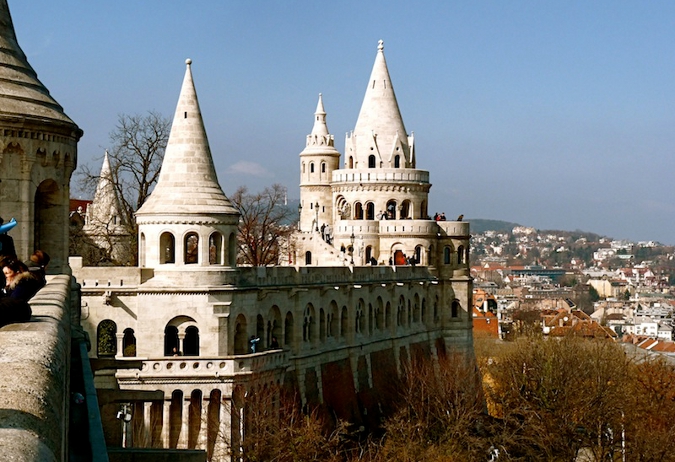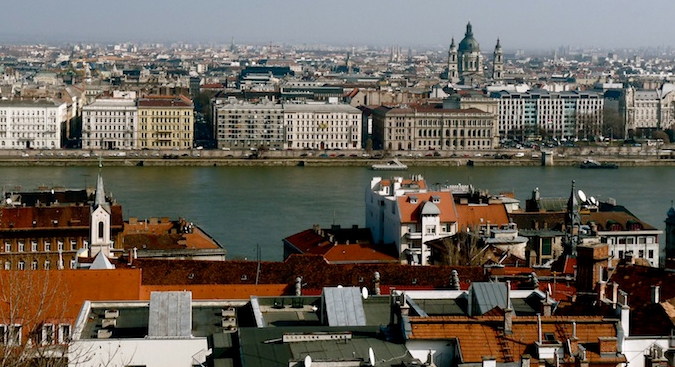For Czech history enthusiasts, a visit to Hungary’s capital is a must as the Czech Republic was a former component of the Austrio-Hungarian Empire for half a millennium. The small(er) country of Hungary has worked hard to rebuild itself economically, culturally, and architecturally after WWII and the communist era, much like here in the Czech Republic. The two countries share a great deal of similarities given its historical ties and geographical proximity.
Budapest is yet another one of those underrated, inexpensive (think Monopoly money) eastern European destinations that the average tourist may overlook. But for those who hate overcrowded cities like Paris or want to escape the hustle and bustle of Prague during tourist season, a train ride to nearby Budapest may do just the trick. Budapest is an architectural haven full of neoclassical, art nouveau, and baroque style historic buildings. With a myriad of parks, thermal baths, hip bars and cafes, the city evokes a similar Eastern European charm found here in Prague along with an alternative vibe reminiscent of Berlin. Nonetheless, it feels much more off the beaten path.
Getting There and Around
There are six daily trains that run to Budapest from Prague’s main train station (Praha Hlavní Nádraži). Two night trains are also offered with beds/couchettes. They all arrive at Budapest Keleti pu (Budapest Eastern Railway Station) and the journey takes approximately 7-8 hours and costs about 50 EUR for 2nd class, one-way tickets. However, E-tickets begin at 30 EUR and can be purchased through Czech Transport.
A cheaper, but slightly less comfortable option is to take a bus. Eurolines, Student Agency, and Orangeways service Budapest and offer cheap rates. Tickets can be as cheap as 30 EUR round trip if booked in advance.
Once in Budapest, public transit is very easy to use. There are only three metro lines and an efficient tram and bus network. All of the public transportation runs from 04:30 to 23:00. (But fear not lovers of the night, there are 37 night bus lines!) Upon arrival by bus, getting into the city center is quite easy. From Népliget (the bus station), line 3 runs north and south along the river. From the train, Keleti pu is located on line 2 that runs east and west.

Heroes’ Square
Tickets can be purchased at the metro stations in person or by machine. A single ticket costs 320 HUF and allows 1 metro transfer but does not allow a transfer on buses and trams. A 10 single ticket book costs 2800 HUF and may be more worthwhile. Day and month passes are also available. The Budapest card allows you unlimited free travel in the city and comes with discounts to museums and restaurants. The 2-day card costs 6300 HUF and the 3-day card costs 7500 HUF. Despite the many transit options available, another great way to see the city is by foot. Once in the city center, a lot of the major sites are pretty concentrated and Budapest is a very walk-able city.
Tourist Information
There are two official tourist offices in the city center at Deák Ferenc tér and Liszt Ferenc tér, as well as three offices at the airport terminals. Each information point has free leaflets, and maps and listings magazines. They also sell the Budapest card and it is possible to book shows, concerts, and sightseeing tickets here as well.
What to See
“Budapest” is actually a composition of the cities “Buda” and “Pest”, which were united as a single city in 1873. The Danube River runs between Buda and Pest. Castle Hill is located on the Buda side of town, which has a calm and quiet atmosphere—similar to Prague’s Mala Strana. Pest is more of the business and administrative center of Budapest with its plethora of restaurants, bars, cafes, museums, and clubs. The layout is very similar to Prague, with bridges connecting the two sides. The most famous bridge is the Chain Bridge, which is suspended by huge chain links and provides a beautiful stroll across the river.
Castle Hill
Castle Hill is located on the Buda side and contains many of Budapest’s famous attractions such as: the Royal Palace, National Gallery, Fisherman’s Bastion, Matthias Church, the Historical Museum of Budapest, the Music Museum, the Military Museum, Marzipan Museum, Pharmacy Museum, and the Museum of Medieval Judaism. This hill is the perfect spot to witness the medieval character of Buda that has been carefully preserved throughout the years. Castle Hill, along with the entire panorama of the Danube, has been designated a World Heritage preservation site by UNESCO. The Firsherman’s Bastion and lookout terrace provides one of the most impressive and free panoramic views of the Danube and Pest. Another must-see is Castle Hill’s most popular attraction—the Royal Palace, which was erected in the 14th century and home to Hungarian kings for 700 years.

Fisherman’s Bastion
Gellert Hill
While Castle Hill provides a stunning view of the Pest side, a hike up to the Citadel on Gellert Hill, which is a protected nature reserve, reveals a view of both sides of the river. Gellert Hill is also home to three famous thermal spas—Gellert baths and the Turkish baths Rudas and Rác.
Pest
Pest is modern day Budapest, with never-ending streets full of shops, cafes, and restaurants. Some famous sights in downtown Pest are: the Parliament Building, St. Stephen’s Basilica, Great Synagogue and the Jewish Museum, Eötvös Loránd University, National Museum, and Holocaust Memorial Center. The Parliament Building is one of the most beautiful examples of Neo-gothic architecture situated overlooking the Danube. The Parliament building provides free, guided tours for citizens of the EU. Tickets are sold at 08:00 everyday but sell out very quickly.
Just south east of the Parliament building is Andrássy Út Boulevard that stretches from downtown Pest to the City Park in the North East of Budapest. Listed on UNESCO’s World Heritage List, this boulevard has many attractions such as: the State Opera House, the House of Terror, the Hopp Museum of East Asian Art, Ernst Museum and the City Park. Both sides of this boulevard are lined with eclectic 19th and 20th century mansions.
For those who are brave enough to endure a very depressing, yet well-done, award-winning museum, the House of Terror is definitely worth checking out. It was built in an old secret police building and visitors can see actual cells where political prisoners were kept in. The museum highlights the terror during the Nazi and Communist eras.
Just south of Andrássy is the best place to experience Budapest’s alternative nightlife scene—Szimpla Kert. From the outside, the bar/cinema looks unobtrusive off the narrow, hidden street. However, once inside, visitors are taken to a whole new world. This multi-story bar features many different rooms, an open courtyard, mix-matched couches, chairs, and furniture of all kinds, and a cinema that plays alternative movies. The décor makes you feel like you’re in Never Never Land, with many different colored hanging string lights, trees and plants, a hookah room, and great ambience. It’s very Berlin-esque and a popular spot amongst locals and visitors.
At the other end of Andrássy Út Boulevard is the expansive, green, City Park. Leading up to the park is Heroes’ Square, which features the Millennium Monument. Heroes’ Square honors Hungary’s founders, kings, generals, and politicians. To the left of the square is the Museum of Fine Arts, which contains the richest art collection in Hungary. Inside the park is a pond that doubles as a romantic setting with couples in rowboats in the summer and an ice-skating rink in the winter. Just within the park is also Széchenyi Spa, the largest health spa in Europe.
West of the Park is Margaret Island, another green oasis in the middle of Budapest. The island is the perfect destination for a breezy summer day. Here, it is possible to rent bikes or just explore on foot. In the summer, the Open-air Theater offers musical performances in the evening. The island also features many gardens, a small zoo, swimming pools, thousands of trees, and plenty of nature—the perfect escape from the city life.

Pest
Baths
No visit to Budapest is complete without a therapeutic afternoon at one of the city’s many, glorious thermal spas. From traditional and Turkish baths to modern baths—Budapest has so much to offer in terms of relaxation.
For a Hungarian thermal experience (don’t worry, swimming suits are obligatory), try out Gellert or Széchenyi. Gellert is built in Art Nouveau style with beautiful baths and pools. 3500 HUF gets you entrance to both the swimming pool and thermal facilities. Széchenyi rivals Gellert in terms of beauty. There are 3 outdoor pools, sauna rooms, and several indoor pools at various temperatures. 3100 HUF gets you access to all the pools and sauna rooms. Both of these baths have changing rooms, lockers, massage services, food, drinks, and more to facilitate a soothing day at the spa.
If you’re looking for something more culturally diverse, there’s always the Turkish baths. Rudas exudes an authentic Turkish feel. It is very popular amongst locals and more authentic than Gellert or Szechenyi. Two components make up the bath—the Turkish relaxation bath and the swimming hall. 3300 HUF gets you entrance into both.
Despite the growing power and status of Hungary, the often forgotten country continues to be in the shadow of its European neighbors. Perhaps this is a good thing, and Budapest can be a secret jewel of a destination, free of crowds of tourists. It’s a perfect weekend getaway for those Czech natives who are itching for a few days of culture, architectural beauty, art, relaxation, and nature. For those who still have trouble grasping what Hungary is all about, this video explains it all:
Related articles
- 10 Travel Articles That’ll Get You Excited for Autumn In the Czech Republic
- VIDEO: Amazing Recreation of 14th-Century Construction of Charles Bridge
- Prague Is the Cheapest City In Europe for Ballet, Opera, Art
- Český Krumlov Mulls Over Charging Tourists a Toll
- New Travel Guide Puts Czech Monasteries On the Map












 Reading time: 8 minutes
Reading time: 8 minutes 



















